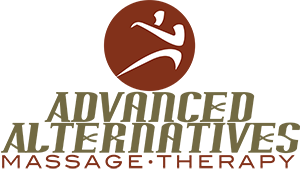Where is your Leg Pain?
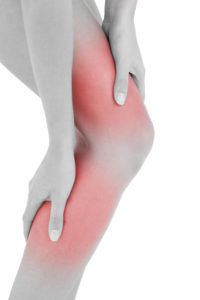 Our lower extremities are complex and support the weight of our body. This gives much opportunity for possible injury as we move through life. Most common injuries of the Leg are :
Our lower extremities are complex and support the weight of our body. This gives much opportunity for possible injury as we move through life. Most common injuries of the Leg are :
Pulled / Strained Hamstrings & Quadrocepts
Massage Therapy Can Help!
At Advanced Alternatives, we understand that your Leg pain can be extremely painful and mentally challenging…and we’re here to help! Our massage therapists are skilled in Medical Massage, Sports Massage, & Myofascial Release for pain relief. You can count on us to locate, evaluate your symptoms and treat the cause. We Get Results! Our goal is Your Wellbeing!
What is ITBS?
 Iliotibial Band Syndrome (ITBS) is a common injury among runners and is characterized by pain or aching at the lateral side of the knee, which generally occurs partway into a run. As the condition worsens, the pain gets more intense and onset occurs closer to the beginning of the workout.
Iliotibial Band Syndrome (ITBS) is a common injury among runners and is characterized by pain or aching at the lateral side of the knee, which generally occurs partway into a run. As the condition worsens, the pain gets more intense and onset occurs closer to the beginning of the workout.
Iliotibial Band Syndrome symptoms range from a stinging sensation just above the knee joint on the outside of the knee or along the entire length of the femur. The pain may not occur immediately during activity, but may intensify over time, or may persist after activity.
Common Cause of ITBS
Hip abductor muscle weakness, most commonly in the gluteus medius, is one of the main causes of ITBS. Although the pain is felt at the knee, the root of the problem is actually located closer to the hip. The tensor fascia lata muscle inserts into the ITB and is responsible for hip abduction. When other hip abductors such as the gluteus medius are weak, the tensor fascia latae must compensate. The end result is an overworked tensor fascia lata and a stressed and tight ITB. The tight ITB will rub on the femur (actually on the femoral area on lateral side of knee) and cause friction. The friction leads to inflammation in the area and pain.
What are Pulled / Strained Hamstrings?
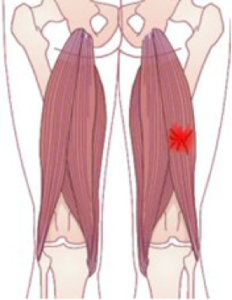 A pulled or strained hamstring is a tear in one or more of the hamstrings muscles. Strictly speaking there are three hamstring muscles (Semitendinosus, Semimembranosus and Biceps femoris) which are known as the hamstring muscle group. All of these muscles travel across the knee joint – and insert at the head of the bones of the lower leg.
A pulled or strained hamstring is a tear in one or more of the hamstrings muscles. Strictly speaking there are three hamstring muscles (Semitendinosus, Semimembranosus and Biceps femoris) which are known as the hamstring muscle group. All of these muscles travel across the knee joint – and insert at the head of the bones of the lower leg.
The hamstrings function predominantly in extending the hip and flexing the knee joints. Understanding how the hamstrings work gives vital clues as to their modes of injury. Acute, mild to severe hamstring strains are extremely common in sprinters and hurdle jumpers and in all sports that involve sprinting activities, such as football and rugby.
Strains are graded 1, 2 or 3 depending on severity.
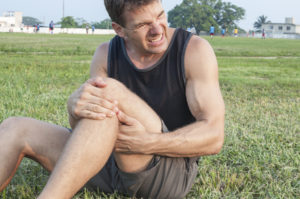 Grade 1: May have tightness in the posterior thigh. Probably able to walk normally however will be aware of some discomfort Minimal swelling.
Grade 1: May have tightness in the posterior thigh. Probably able to walk normally however will be aware of some discomfort Minimal swelling.
Grade 2: Gait will be affected-limp may be present . May notice swelling. Pressure increases pain. Flexing the knee against resistance causes pain. Might be unable to fully straighten the knee.
Grade 3: Walking severely affected- may need walking aids such as crutches. Severe pain- particularly during activity such as knee flexion.
Noticeable swelling visible immediately.
Preventative Measures: One of the most important methods of preventing a pulled hamstring is to warm up correctly- this has been scientifically proven to reduce the risk of hamstring strain.
A specific strengthening program for the hamstring muscle group is vital in those athletes regularly undertaking sprinting and high velocity sports. It is extremely important to continue to strengthen all other muscles in the region of the thighs, pelvis and lower back to ensure correct muscle balance.
What are Pulled / Strained Quadriceps?
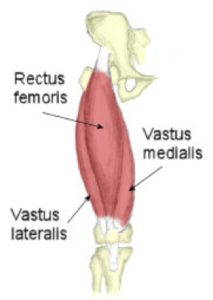 The quadriceps muscles consist of the vastus lateralis, vastus medialis, vastus intermedius and the rectus femoris. Any of these muscles can strain (or tear) but probably the most common is the rectus femoris. A strain is a tear in the muscle.
The quadriceps muscles consist of the vastus lateralis, vastus medialis, vastus intermedius and the rectus femoris. Any of these muscles can strain (or tear) but probably the most common is the rectus femoris. A strain is a tear in the muscle.
Causes of Quadriceps Strain
- Stretching the quadriceps beyond the amount of tension or stress that they can withstand.
- Suddenly putting stress on the quadriceps when the muscle is not ready for the stress.
- Using the quadriceps too much on a certain day.
- A blow to the quadriceps.
Preventative Measures: One of the most important methods of preventing a Quadriceps Strain is to warm up correctly- this has been scientifically proven to reduce the risk of Quadriceps Strain.
 Keep your quadriceps muscles strong so they can absorb the energy of sudden physical stress.
Keep your quadriceps muscles strong so they can absorb the energy of sudden physical stress.- Learn the proper technique for exercise and sporting activities. This will decrease stress on all your muscles, including your quadriceps.
- Ice, compress and elevate, Sports Massage to flush edema from tissue.
- Wear a heat retainer or support.
- Use sports massage techniques to speed up recovery (very important).
The trained therapists at Advanced Alternatives Massage Therapyare skilled in the use of sports massage The application of Myofascial Release and or Lymph edema Therapy has proven effective in restoring flexibility and flushing excess fluid from hypertonic tissue.
Massage Therapy for Calf Strain
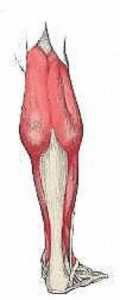 What are the calf muscles?
What are the calf muscles?
The calf muscles consist of the Gastrocnemius which is the big muscle at the back of the lower leg and the Soleus muscle which is a smaller muscle lower down in the leg and under the Gastrocnemius.
The most common place to get this injury is half way between the knee and the heel.
If the Soleus muscle is damaged you might get pain lower in the when you contract the muscle against resistance with the knee bent.
Symptoms of calf strain include:
- A sudden pain at the back of the leg.
- Difficulty in contracting the muscle or standing on tip toe.
- Pain when pointing or flexing your foot.
Causes of Calf pain
Ineffective warm up and warm down routines can lead to calf strains.
Excessive hill work and a sudden increase in mileage can cause a calf strain. Many runners carry on running even after the initial signs of a calf strain. Many runners don’t adequately hydrate. Deficiencies in calcium, trace minerals and magnesium can also lead calf strains.
One of the most common causes is a condition called over pronation. Over pronation basically means that your feet are rolling over too much as you run which causes excessive pressure on the calf muscle and Achilles tendon.
 Preventative Measures: Recommended actions to reduce the chance of calf muscle strain:
Preventative Measures: Recommended actions to reduce the chance of calf muscle strain:
- Keep your calf muscles strong so they can absorb the energy of sudden physical stress.
- After a short warm-up period, stretch out your calf muscles before physical activity.
- Learn the proper technique for exercise and sporting activities.
- For rehabilitation of muscle strains, the therapists at Advanced Alternatives Massage Therapy have specialized training in sports massage which is very important in softening / preventing scar tissue forming at the site of injury. This will help prevent re-injury. Connective tissue is softened, blood is circulated to help the cells get the nutrients they need for optimum function & the muscles can be stretched laterally (sideways) with massage in a way that normal stretching cannot achieve.
Massage Therapy for Shin Splints
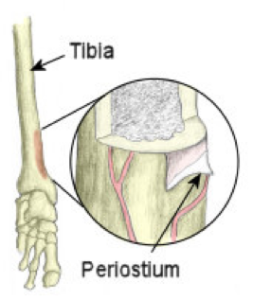 Do you have Shin Splints?
Do you have Shin Splints?
Shin splints is the general name given to pain at the front of the lower leg. Shin splints is not a diagnosis in itself but a description of symptoms of which there could be a number of causes.
Symptoms of Shin Splints
- Tenderness over the inside of the shin.
- Lower leg pain which goes after a period of rest but comes back when running starts again.
- Sometimes some swelling.
- Lumps and bumps may be felt when feeling the inside of the shin bone.
- Pain when the toes or foot are bent downwards.
- A redness over the inside of the shin.
Causes of Shin Splints
The most common cause is inflammation of the periosteum of the tibia (sheath surrounding the bone). Traction forces occur from the muscles of the lower leg on the periosteum causing shin pain and inflammation.
Another primary culprit causing shin splints is a sudden increase in distance or intensity of a workout schedule. This increase in muscle work can be associated with inflammation of the lower leg muscles, those muscles used in lifting the foot (the motion during which the foot pivots toward the tibia). Such a situation can be aggravated by a tendency to pronate the foot (roll it excessively inward onto the arch).
Similarly, a tight Achilles tendon or weak ankle muscles are also often implicated in the development of shin splints.
Preventative Measures:
The following guidelines are for information purposes only. Seeking professional advice before beginning rehabilitation is recommended.
Prevention, rather than a cure, should always be your first aim.
- A thorough and correct warm up will help to prepare the muscles and tendons for any activity to come. Without a proper warm up the muscles and tendons will be tight and stiff. There will be limited blood flow to the lower legs, which will result in a lack of oxygen and nutrients for those muscles. Flexible muscles are extremely important in the prevention of lower leg injuries.
When muscles and tendons are flexible and supple, they are able to move and perform without being over stretched.
- Massage Therapy
 The therapists at Advanced Alternatives Massage Therapy are have specialized training in techniques to help relieve swelling, decrease muscle tension, prevent adhesions, and restore balance to supporting muscles.
The therapists at Advanced Alternatives Massage Therapy are have specialized training in techniques to help relieve swelling, decrease muscle tension, prevent adhesions, and restore balance to supporting muscles.
- The basic treatment for shin splints is no different to most other soft tissue injuries. Immediately following the onset of any shin pain, the R.I.C.E. regime (Rest, Ice, Compression & Elevation) It is critical that the R.I.C.E regime be implemented for at least the first 48 to 72 hours.
Doing this will give you the best possible chance of a complete and full recovery.
- Referral to an appropriate professional for an accurate diagnosis should be applied to have stress fractures ruled out.
Schedule a Treatment!
1910 Buford Boulevard * Tallahassee
850-325-1331
Therapists Available 7 Days A Week by Appointment
Why Choose Advanced Alternatives?
The following guidelines are for information purposes only. Seeking professional advice before beginning rehabilitation is recommended.
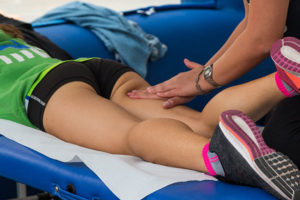 We can help relieve your leg pain no matter what the cause.
We can help relieve your leg pain no matter what the cause.
Regular deep tissue sports massage performed by our skilled therapists at Advanced Alternatives Massage Therapy can help prevent muscle strains by increasing flexibility within the lower leg muscles. The application of Myofascial Release has proven effective in restoring flexibility to hypertonic tissue. We’ll review your posture and help assess the actual cause of your pain, then suggest a treatment plan to get you feeling better fast!
